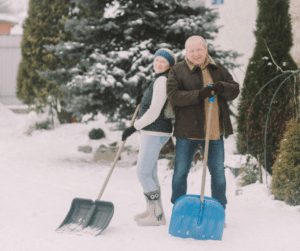Understanding winter’s effects – with its cold temperatures and hazardous accumulation of snow, sleet and ice – on your well-being and knowing the precautions to take are important to your health and safety. When faced with frigid temperatures and hazardous cold weather conditions, we recommend you follow these tips.
1. Dress in Layers for Cold Weather Comfort: When venturing outdoors on cold and windy days, dress warmly to minimize exposure to the elements. Layering is key:
• Start with a lightweight, heat-retaining fabric like polyester, silk or merino wool.
• Then add an insulating layer, such as fleece, to trap heat close to the body.
• Finally, add an outer layer that protects against wind, rain and snow. Wet clothing loses its insulation, so change wet clothes frequently.
2. Protect Your Heart in Cold Weather: Cold weather adds extra strain on the heart, constricting blood vessels to conserve energy resulting in the heart working harder. This is especially risky if you have heart disease or high blood pressure. Take care of your heart by:
• Avoiding over-exertion and taking frequent rest breaks when outdoors.
• Staying hydrated to ensure cardiovascular safety during winter exercise or work.
3. Prevent Cold-weather Injuries: Walking on snow and ice poses significant risks. Many injuries occur from falls on icy surfaces. Although it’s best to stay indoors until conditions are safe and surfaces are cleared, sometimes it’s not feasible. If you do have to venture outside, make sure to:
• Exercise caution on ice-covered sidewalks, steps, driveways and porches.
• Hold onto railings where available.
• Walk slowly taking small steps with your feet positioned like a penguin.
4. Be Informed and Prepared for Winter Travel: Stay informed of travel conditions through radio, TV or online sources. When traveling, you should:
• Share your destination and expected arrival time with someone.
• Prepare an emergency kit for your car, including essentials like a blanket, jumper cables, water, snacks, flashlight, ice scraper, cell phone charger and a first aid kit.
5. Maintain Fitness During Cold Weather Months: Continue your fitness routine, and if outdoor exercise isn’t possible, explore indoor alternatives:
• Walk hallways or use gym equipment like treadmills, bikes or NuStep.
• For personalized fitness guidance, contact a certified personal trainer.
Following these five cold weather safety tips will support your well-being including keeping your body warm, protecting your heart from extra strain, moving your fitness routine inside, and reducing your risk of an outdoor accident and lack of preparedness if one does happen.
Discover more tips to help you age well.
About the Author
Sherry Stick is the fitness and aquatics coordinator at Carroll Lutheran Village and has been working for CLV for nearly 20 years.
